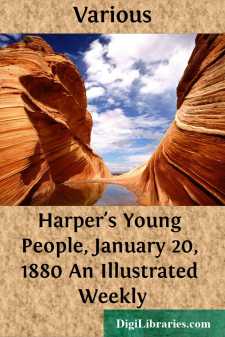Categories
- Antiques & Collectibles 13
- Architecture 36
- Art 48
- Bibles 22
- Biography & Autobiography 813
- Body, Mind & Spirit 142
- Business & Economics 28
- Children's Books 17
- Children's Fiction 14
- Computers 4
- Cooking 94
- Crafts & Hobbies 4
- Drama 346
- Education 46
- Family & Relationships 57
- Fiction 11829
- Games 19
- Gardening 17
- Health & Fitness 34
- History 1377
- House & Home 1
- Humor 147
- Juvenile Fiction 1873
- Juvenile Nonfiction 202
- Language Arts & Disciplines 88
- Law 16
- Literary Collections 686
- Literary Criticism 179
- Mathematics 13
- Medical 41
- Music 40
- Nature 179
- Non-Classifiable 1768
- Performing Arts 7
- Periodicals 1453
- Philosophy 64
- Photography 2
- Poetry 896
- Political Science 203
- Psychology 42
- Reference 154
- Religion 513
- Science 126
- Self-Help 84
- Social Science 81
- Sports & Recreation 34
- Study Aids 3
- Technology & Engineering 59
- Transportation 23
- Travel 463
- True Crime 29
Harper's Young People, January 20, 1880 An Illustrated Weekly
by: Various
Categories:
Description:
Excerpt
"As we have already," began the Professor, "had a talk about the stars in general, let us this morning give a little attention to our own particular star."
"Is there a star that we can call our own?" asked May, with unusual animation. "How nice! I wonder if it can be the one I saw from our front window last evening, that looked so bright and beautiful?"
"I am sure it was not," said the Professor, "if you saw it in the evening."
"Is it hard to see our star, then?" she said.
"By no means," replied the Professor; "rather it is hard not to see it. But you must be careful about looking directly at it, or your eyes will be badly dazzled, it is so very bright. Our star is no other than the sun. And we are right in calling it a star, because all the stars are suns, and very likely give light and heat to worlds as large as our earth, though they are all so far off that we can not see them. Our star seems so much brighter and hotter than the others, only because it is so much nearer to us than they are, though still it is some ninety-two millions of miles away."
"How big is the sun?" asked Joe.
"You can get the clearest idea of its size by a comparison. The earth is 7920 miles in diameter, that is, as measured right through the centre. Now suppose it to be only one inch, or about as large as a plum or a half-grown peach; then we would have to regard the sun as three yards in diameter, so that if it were in this room it would reach from the floor to the ceiling."
"How do they find out the distance of the sun?" asked Joe.
"Until lately," replied the Professor, "the same method was pursued as in surveying, that is, by measuring lines and angles. An angle, you know, is the corner made by two lines coming together, as in the letter V. But that method did not answer very well, as it did not make the distance certain within several millions of miles. Quite recently Professor Newcomb has found out a way of measuring the sun's distance by the velocity of its light. He has invented a means of learning exactly how fast light moves; and then, by comparing this with the time light takes to come from the sun to us, he is able to tell how far off the sun is. Thus, if a man knows how many miles he walks in an hour, and how many hours it takes him to walk to a certain place, he can very easily figure up the number of miles it is away."
"Why," said Gus, "that sounds just like what Bob Stebbins said the other day in school. He has a big silver watch that he is mighty fond of hauling out of his pocket before everybody. A caterpillar came crawling through the door, and went right toward the teacher's desk at the other end of the room. 'Now,' said Bob, 'if that fellow will only keep straight ahead, I can tell how long the room is.' So out came the watch, and Bob wrote down the time and how many inches the caterpillar travelled in a minute. But just then Sally Smith came across his track with her long dress, and swept him to Jericho. We boys all laughed out; Sally blushed and got angry; and the teacher kept us in after school."
"Astronomers have the same kind of troubles," said the Professor. "They incur great labor and expense to take some particular observation that is possible only once in a number of years, and then for only a few minutes....












